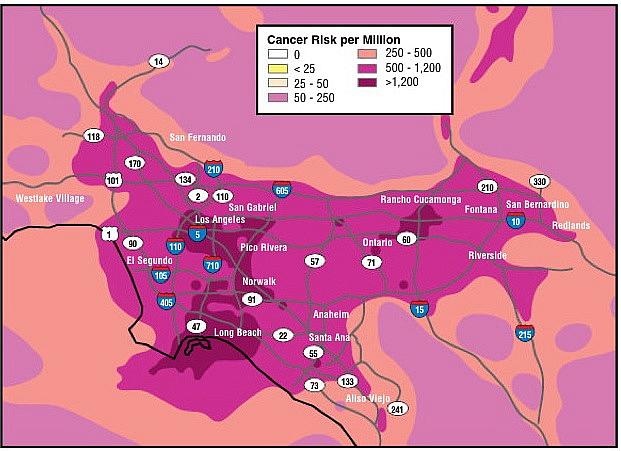In the Air
What is air pollution doing to our kids?
If you live in L.A. County, and especially if you've driven back to the Los Angeles basin from somewhere else, you've seen it. A steely brown haze hangs over us for much of the year. We live in the smoggiest region in the United States (according to the South Coast Air Quality Management District), but for those raising children here it may not be top of mind. In some parts of the county, moms claw their way onto waiting lists for the "right" preschool while they are still pregnant. Concerns about finding the right neighborhood, the right school, about keeping kids away from gangs and drugs or getting them to turn off the Xbox and do some homework tend to take center stage. The air we breathe gets plenty of media coverage, but we tend to consider it more of an inconvenience than an emergency.
Yet at every stage of children's lives – from their time in the womb until they're ready to leave the nest – the pollution in the air impacts their health. This project -- a 5-part series of articles in L.A. Parent magazine and on my blog, plus additional articles published online -- is designed to help the parents of the L.A. basin understand the impact of the air their children breathe, and what they can do to help clear the air.
Other parts of the series:

Eight weeks without food. Five days without water. Three minutes without air. In the world of survival math, breathing is at the top of almost every equation. But here in the L.A. Basin, we inhale much more than life-sustaining oxygen, drawing in a mix of ozone, carbon monoxide, nitrogen dioxide, sulfer dioxide, lead and airborne particles.
Researchers decades ago pegged ozone as the major culprit behind short-term smog troubles like acute asthma attacks and shortness of breath, and suspected it also caused long-term health effects like heart disease and lung cancer. But about 10 years ago, the venerable Children’s Health Study, launched in 1992 to find out more about how air pollution affects kids, began to focus more attention on traffic-related pollutants. During the past four years, they have zeroed in on the health effects of particulate matter, especially the smallest particles – and the chemicals that piggyback with them into our bodies.
Other researchers are now carefully piecing together a road map that could prove these particles as the cause, not just an aggravator, of asthma – a connection that could finally account for growing rates of the disease.
The Environmental Protection Agency (EPA) regulates PM10s, which are smaller than 10 microns in diameter, and PM2.5s, particles smaller than 2.5 microns. (For comparison, a human hair is 50-70 microns.) These are stirred up by cars and construction, spewed from truck tailpipes and industry, and also created in the atmosphere.
“Area-wide pollution” shows up throughout the basin when wind blowing from the ocean drives emissions inland, explains Suzanne Paulson, Ph.D., vice chair of the UCLA department of Atmospheric and Oceanic Sciences. As the air travels, the sun shining from above forms a high-pressure system that traps the emissions near the land and “brews” them into photo-chemical smog. The farther east the air moves, the more time it has had in the sun, and the stronger the brew. “By the time the air that was on the ocean in the morning reaches San Bernardino, it’s had time to react,” says Paulson. This explains the haze that often hangs over the Inland Empire on sunny afternoons.
“Direct emissions” refers to pollution that hangs out near where it was created. The map below offers one view of direct emissions, detailing the risk of getting cancer from a lifetime of exposure in different parts of the Basin. Note the sinister dark blotches near the ports, and where major freeways converge. The government’s Multiple Air Toxics Exposure Study III (MATES III) research, which produced the map, didn’t include ultrafine particles, but other researchers have found that the particles are most concentrated near freeways.
“If you are on a freeway, you have about 500,000 ultrafine particles in an area the size of a sugar cube,” says John Froines, Ph.D., who studies the particles as director of the Center for Occupational and Environmental Health at UCLA. Not currently monitored or regulated by the government, ultrafines are 0.1 microns in diameter, small enough to burrow deep into our cells, releasing toxic chemicals that come along for the ride. “It’s not just the ports that are affected,” Froines says. “When you start to think about these trucks traveling across all these freeways, it affects the entire Los Angeles Basin.”
And it affects us throughout our lives – and especially our children. As we learn more about this threat, medical societies, public health groups and others locally and across the country have begun to clamor for stricter government regulation. Over the coming months this series will examine the impact of the air we breathe on our unborn babies, children and teens, and look at what is being done to turn the tide and clear the air. Visit LAParent.com for more pollution maps, and a glossary of pollutants. And look for future articles in L.A. Parent, plus updates on our website and via Facebook and Twitter.
Got a question or a story to tell? Contact me at Christina.Elston@Parenthood.com.

